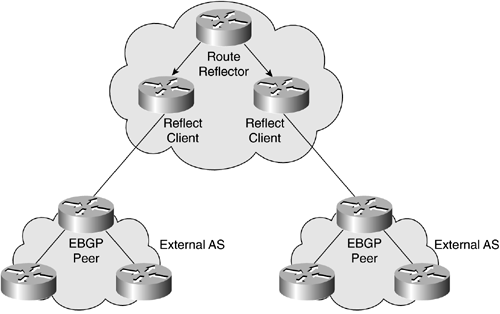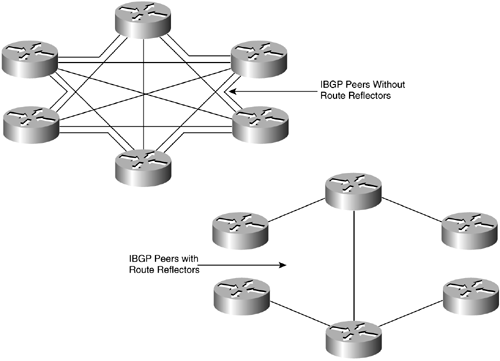BGP Route Reflectors
To help reduce the amount of peers a router will have in an Autonomous System, BGP employs the use of route reflectors. The routers peer with another router, or concentration router. These peers are then known as clients. They receive updates from and send updates to the route reflector.
The use of route reflectors is one way to reduce the size of the IBGP routing mesh. The issue with meshed IBGP routes is scalability. Routing meshes are subject to the N-squared algorithm, N2 N/2, also represented as N(N 1)/2, where N is the number of nodes in the network. As internetworks and autonomous systems grow, so will the size of each BGP router's routing table at the rate of N(N 1)/2 for each additional node (N), as illustrated in Figure D-7.
Figure D-7. BGP Route Reflector Topology

In a BGP Autonomous System, there can be several routers exchanging route information. To reduce the amount of peers a router has to establish, a concentration router or route reflector router can be configured. Reflect clients are configured to exchange information with a central concentration router (route reflector). Reflect clients (client peers) peer only with the central concentration router instead of every router in the Autonomous System. The central router (route reflector) is responsible for sending updates to the reflector clients. The reflector clients are responsible for sending updates to the central concentration router instead of every router in the AS. Routers not configured as route reflector clients are known as non-client peers. The route reflector "reflects" routes between client peers and non-client peers and is illustrated in Figure D-8.
Figure D-8. BGP With and Without Route Reflectors

As the previous figure shows, the benefit of route reflectors is that IBGP peers do not have to be fully meshed with each other to receive full-mesh routing updates. The sole requirement is for each IBGP client peer to have a session established with the route reflector. Non-client peers will require full-mesh connectivity with other non-client peers, and those must be configured as route reflectors. Router reflector clients can communicate only with the route reflector, not with non-client peers.
NOTEIt is a good networking practice to have the router reflector topology mirror the physical network topology. |
EAN: 2147483647
Pages: 269
- Structures, Processes and Relational Mechanisms for IT Governance
- Integration Strategies and Tactics for Information Technology Governance
- An Emerging Strategy for E-Business IT Governance
- Linking the IT Balanced Scorecard to the Business Objectives at a Major Canadian Financial Group
- Governance in IT Outsourcing Partnerships